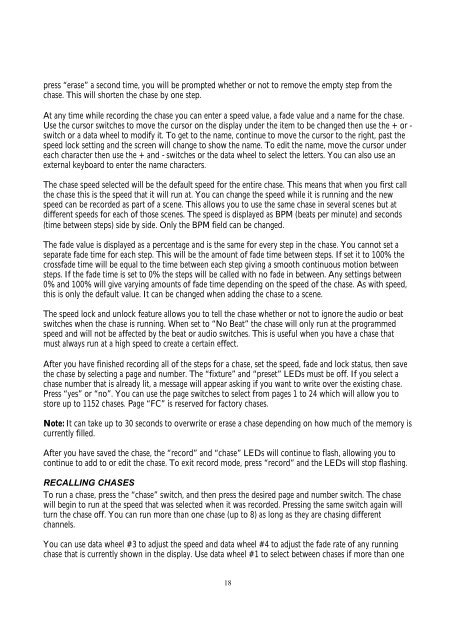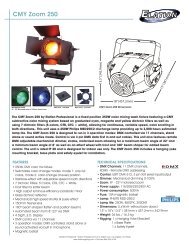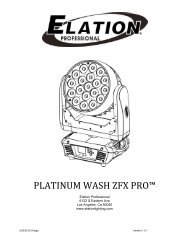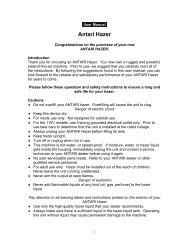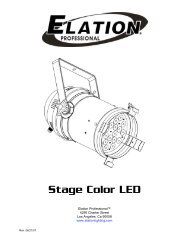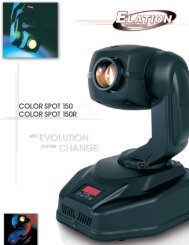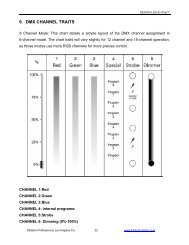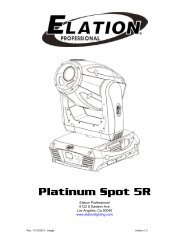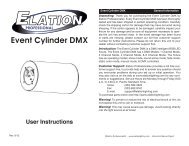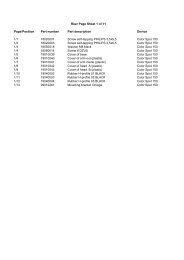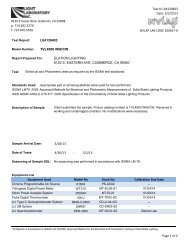You also want an ePaper? Increase the reach of your titles
YUMPU automatically turns print PDFs into web optimized ePapers that Google loves.
press “erase” a second time, you will be prompted whether or not to remove the empty step from thechase. This will shorten the chase by one step.At any time while recording the chase you can enter a speed value, a fade value and a name for the chase.Use the cursor switches to move the cursor on the display under the item to be changed then use the + or -switch or a data wheel to modify it. To get to the name, continue to move the cursor to the right, past thespeed lock setting and the screen will change to show the name. To edit the name, move the cursor undereach character then use the + and - switches or the data wheel to select the letters. You can also use anexternal keyboard to enter the name characters.The chase speed selected will be the default speed for the entire chase. This means that when you first callthe chase this is the speed that it will run at. You can change the speed while it is running and the newspeed can be recorded as part of a scene. This allows you to use the same chase in several scenes but atdifferent speeds for each of those scenes. The speed is displayed as BPM (beats per minute) and seconds(time between steps) side by side. Only the BPM field can be changed.The fade value is displayed as a percentage and is the same for every step in the chase. You cannot set aseparate fade time for each step. This will be the amount of fade time between steps. If set it to 100% thecrossfade time will be equal to the time between each step giving a smooth continuous motion betweensteps. If the fade time is set to 0% the steps will be called with no fade in between. Any settings between0% and 100% will give varying amounts of fade time depending on the speed of the chase. As with speed,this is only the default value. It can be changed when adding the chase to a scene.The speed lock and unlock feature allows you to tell the chase whether or not to ignore the audio or beatswitches when the chase is running. When set to “No Beat” the chase will only run at the programmedspeed and will not be affected by the beat or audio switches. This is useful when you have a chase thatmust always run at a high speed to create a certain effect.After you have finished recording all of the steps for a chase, set the speed, fade and lock status, then savethe chase by selecting a page and number. The “fixture” and “preset” LEDs must be off. If you select achase number that is already lit, a message will appear asking if you want to write over the existing chase.Press “yes” or “no”. You can use the page switches to select from pages 1 to 24 which will allow you tostore up to 1152 chases. Page “FC” is reserved for factory chases.Note: It can take up to 30 seconds to overwrite or erase a chase depending on how much of the memory iscurrently filled.After you have saved the chase, the “record” and “chase” LEDs will continue to flash, allowing you tocontinue to add to or edit the chase. To exit record mode, press “record” and the LEDs will stop flashing.RECALLING CHASESTo run a chase, press the “chase” switch, and then press the desired page and number switch. The chasewill begin to run at the speed that was selected when it was recorded. Pressing the same switch again willturn the chase off. You can run more than one chase (up to 8) as long as they are chasing differentchannels.You can use data wheel #3 to adjust the speed and data wheel #4 to adjust the fade rate of any runningchase that is currently shown in the display. Use data wheel #1 to select between chases if more than one18


